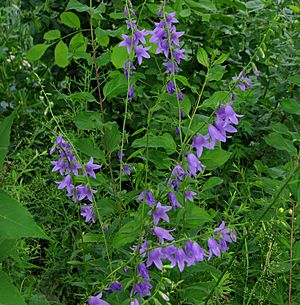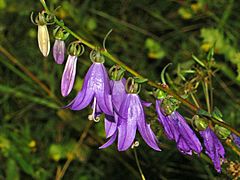Creeping bellflower facts for kids
Quick facts for kids Creeping bellflower |
|
|---|---|
 |
|
| Campanula rapunculoides, Ottawa, Ontario | |
| Scientific classification | |
| Genus: |
Campanula
|
| Species: |
rapunculoides
|
| Synonyms | |
Campanula rapunculoides, often called creeping bellflower or rampion bellflower, is a type of plant. It is a perennial plant, meaning it lives for more than two years. It is also a herbaceous plant, which means it has soft, green stems instead of woody ones. This plant belongs to the Campanula group, which is part of the Campanulaceae family.
Contents
What's in a Name?
The name Campanula rapunculoides has a special meaning. The first part, Campanula, comes from a Latin word. It means "small bell" and describes the bell-like shape of the flower. The second part, rapunculoides, means it looks similar to another plant called Campanula rapunculus.
Plant Description
The creeping bellflower usually grows to be about 30 to 80 centimeters (1 to 2.5 feet) tall. Some can even reach up to 120 centimeters (nearly 4 feet)! Its stem stands straight up and has tiny hairs on it.
The leaves at the bottom of the plant are shaped like triangles. They have jagged edges and can be up to 12 centimeters (almost 5 inches) long. The leaves higher up on the stem are narrower and attach directly to the stem without a stalk.
Flowers and Seeds
The flowers of the creeping bellflower hang down in long clusters. They are usually bright blue-violet, but sometimes they can be white. Each flower is about 2 to 4 centimeters (1 to 1.5 inches) long. They have short stems and grow from the leaf joints.
The flowers have five deep, bell-shaped petals. These petals are slightly fringed. You can see them blooming from June to September. Bees, flies, and butterflies help pollinate these flowers. This means insects carry pollen from one flower to another.
After the flowers, the plant produces a fruit called a capsule. This capsule has five small holes near its base. When the seeds are ready, they spread out from these holes.
How it Spreads
This plant has special buds that survive underground during winter. It also spreads using underground stems called rhizomes. It grows deep, thick roots that look like taproots or tubers. These roots are white and fleshy.
Because even a small piece of these roots can grow into a new plant, the creeping bellflower is very hard to get rid of once it starts growing.
Where it Grows
The creeping bellflower is originally from Europe and western Siberia. However, it has been brought to North America. Here, it has become a very strong invasive weed. This means it spreads quickly and can take over areas. It often crowds out other plants, making it hard for them to grow.
Favorite Places to Live
You can find this plant in many different places. It likes grassy areas, dry hills, and meadows. It also grows in forests, fields, and along roadsides. You might see it near railway lines or hedges.
It prefers places with some shade, not too much sun. It likes soil that is dry to a little moist and rich in nutrients. You can find it from sea level up to 2,000 meters (about 6,500 feet) high. It can even grow in farm fields as a weed.
Gallery
Creeping Bellflower in Alberta
In places like Calgary, Alberta, the creeping bellflower is a big problem. The City of Calgary Parks Department lists it as an invasive plant to avoid. People in Calgary sometimes call it by other names like Rover Bellflower or the "evil twin."
This plant was brought to North America from Europe and became very popular. Each plant can make about 15,000 seeds! It also spreads very well through its long, tuber-like root system. This makes it very difficult to control once it starts growing in an area.
See also
 In Spanish: Campanula rapunculoides para niños
In Spanish: Campanula rapunculoides para niños







